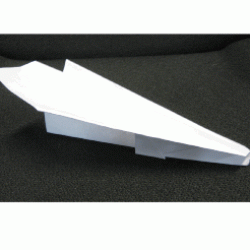Source Institutions
Source Institutions
Add to list Go to activity
Activity link broken? See if it's at the internet archive

In this activity, learners model directed evolution by making paper fly. Learners construct and fly paper airplanes. During the first round, they calculate the average distance the planes fly and then recreate the planes that flew the furthest. Learners repeat this process several times, observe how the average distance of flight changes, and eventually identify the ideal flyer. This activity can be used to introduce learners to genetic random mutations and how scientists are using directed evolution to engineer new proteins with enhanced properties.
- Under 5 minutes
- 45 to 60 minutes
- $1 - $5 per group of students
- Ages 8 - 18
- Activity, Lesson/Lesson Plan, Model
- English
Quick Guide
Materials List (per group of students)
- Paper
- Meter stick or measuring tape
- Plastic straws (optional)
- Index cards (optional)
- Tape (optional)
- Scissors (optional)
- Paper clips or other small attachments (optional)
Subjects
-
Engineering and Technology
-
Engineering
- Aerospace Engineering
- Bioengineering/Biomedical Engineering
-
Engineering
-
Life Sciences
-
Evolution
- Mechanisms of Evolution
-
Heredity and Genetics
- Patterns of Heredity
- Genetic Engineering
-
Evolution
-
Mathematics
-
Data Analysis and Probability
- Data Analysis
- Data Collection
-
Measurement
- Units of Measurement
- Rate
- Number and Operations
-
Data Analysis and Probability
-
The Nature of Technology
-
The Design Process
- Invention and Innovation
-
The Design Process
-
Physical Sciences
-
Motion and Forces
- Projectile Motion
-
Motion and Forces
-
The Nature of Science
-
The Scientific Process
- Conducting Investigations
- Gathering Data
- Formulating Explanations
-
The Scientific Process
Informal Categories
- Toys
- Transportation
Audience
To use this activity, learners need to:
- see
- read
- be mobile
- touch
Learning styles supported:
- Involves teamwork and communication skills
- Involves hands-on or lab activities
Other
This resource is part of:
Access Rights:
- Free access
By:
- Yu, Julie
Rights:
- All rights reserved, Exploratorium, 2009
Funding Sources:
- National Science Foundation, 0610238
- National Science Foundation, 0925383
